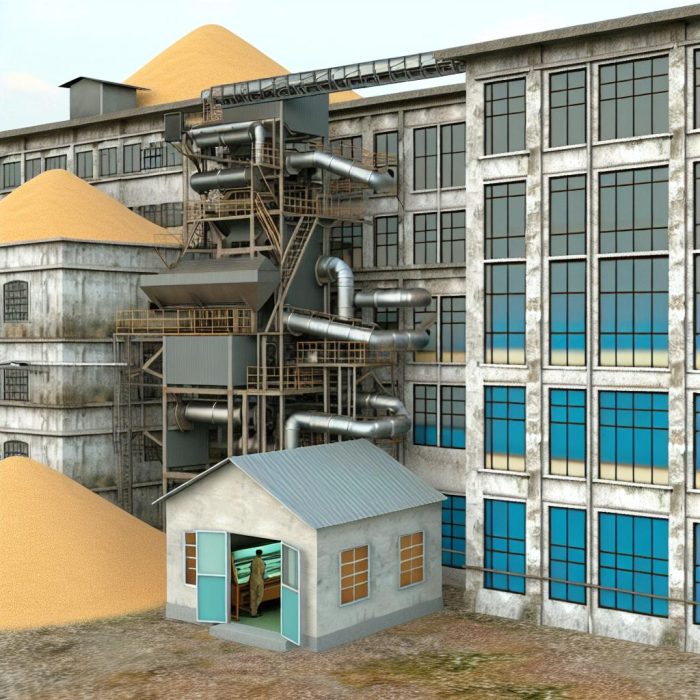Overview of Sugar Mills
Sugar mills are industrial facilities pivotal in transforming raw agricultural materials, such as sugarcane or sugar beets, into consumable sugar. This conversion not only satisfies global sugar demands but also supports extensive agricultural and industrial sectors. Understanding the intricacies of this process reveals the scale and efficiency of these crucial facilities.
Harvesting and Transportation
The journey of sugar production begins in the fields, where either sugarcane or sugar beets are harvested. When it comes to sugarcane, the harvesting can be achieved manually with tools like machetes or enhanced through mechanical harvesters, which can handle the workload more swiftly and efficiently. Speed is essential in this phase to reduce the loss of sucrose content, an integral component for quality sugar. Upon harvesting, the sugarcane is bundled and transported to the mills for immediate processing.
In the case of sugar beets, harvesting relies on specialized machinery designed to pull the beets from the soil, clean away excess dirt, and sometimes even slice them into manageable pieces for transportation. These harvested beets must also be promptly delivered to the sugar mills, where the next stages of processing are conducted.
Processing of Sugarcane and Sugar Beets
Sugarcane and sugar beet processing share similarities in their respective approaches, yet each has distinct methods related to extracting and purifying their natural sugars.
Crushing and Extraction
Initiating the process in sugarcane mills, the stalks are meticulously fed into a progression of rolling mills. These rollers are calibrated to crush the cane, facilitating the extraction of cane juice. This juice becomes foundational for subsequent stages, comprising a mixture of sucrose, water, and an array of impurities needing removal.
Conversely, sugar beet processing involves a phase known as diffusion. Here, the raw beets are initially washed to remove soil and debris before being sliced into strips called cossettes. These are then submerged in hot water, encouraging sugar extraction via diffusion.
Purification and Clarification
Post-extraction, the juices harvested from both sugarcane and sugar beets require purification and clarification, critical for removing impurities. This purification process typically involves the addition of chemicals like lime or carbon dioxide. Lime aids in the settlement of impurities, whereas carbon dioxide can help precipitate some unwanted elements. Following the chemical treatments, the juice is filtered to isolate and eliminate solid particles, resulting in a more refined juice ready for further concentration.
Evaporation and Crystallization
The clarified liquid undergoes further concentration using evaporation. This process often employs vacuum systems to efficiently reduce excess water from the juice without elevating temperatures excessively, thus conserving energy and boosting process efficacy. The result is a dense syrup, conventionally referred to as molasses, rich in sugars ready for crystallization.
The crystallization process is a delicate balance of chemistry and physics, where the syrup is seeded with fine sugar crystals. As these minute crystals encourage growth, larger sugar crystals form while the syrup progressively cools, a critical step for achieving desired sugar granules.
Centrifugation
Following successful crystallization, centrifugation is employed to separate sugar crystals from residual molasses. The centrifuge’s rapid spinning generates a force that effectively isolates sugar crystals, which are then further processed to ensure dryness and cooling before storage. The remaining molasses, still containing sugar and nutritive properties, can be repurposed within the mill or marketed for various uses, such as animal feed or fermentation substrates.
Refining and Packaging
Refining is a process prioritized in most sugar mills, aiming to produce pure white sugar with minimal impurities. This involves dissolving raw sugar in a water solution to extract leftover molasses and imperfections. The cleansed solution is re-crystallized to yield refined sugar crystals.
Once refined, sugar is prepared for market distribution. Packaging may vary widely, covering common formats like granulated sugar, cubes, or specialized forms tailored to unique culinary applications. Innovations in packaging continue to evolve to meet consumer demands and reduce costs.
Sustainability and Environmental Impact
The enormity of sugar production bears significant environmental impacts. Key issues encompass water use, the generation of effluents, and nuanced effects on land use, all provoking concern over sustainable practices. Many sugar mills have recognized this predicament and strive to cultivate enhanced methodologies that mitigate adverse environmental impacts. Strategies include optimizing water consumption, repurposing waste by-products, integrating renewable energy solutions, and installing cogeneration systems that utilize waste for additional power.
Embracing an ethos of sustainability, sugar mills aim to align with global standards for environmental responsibility. To delve deeper into ongoing efforts within the sugar production realm, resources from leading organizations like the Food and Agriculture Organization and the International Sugar Organization provide valuable insights into adapting sustainable practices.
Conclusion
In summary, sugar mills serve as pivotal establishments in the intricate network of global sugar production. They orchestrate a series of well-coordinated, scientifically refined processes from harvest to refinement that are imperative for mass-producing consumable sugar. Despite the challenges posed by environmental concerns, the ongoing drive towards sustainable innovations is promising, reflecting a pragmatic approach towards ensuring the growth and resilience of the sugar industry. By understanding and continuously enhancing these practices, the industry can nourish sustainable growth that serves ecological, economic, and societal needs.



